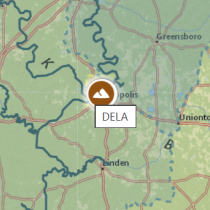NEON Concludes Site Assessments
November 2, 2008
Science staff from the National Ecological Observatory Network have now completed detailed site assessments of all 20 candidate core sites chosen for the continental-scale ecological research platform. Each candidate site, located in a wildland area, represents the vegetation, soils, landforms, climate, and ecosystems performance of its given NEON domain (Mid-Atlantic, Southern Plains, Pacific Northwest, and so forth).
Candidate sites are located across the continental United States, including two in Alaska and one each in Hawaii and Puerto Rico. Information gained from the site assessments is enabling Observatory staff to refine the scientific, technical, logistical, and financial information needed for the upcoming reviews of NEON by the National Science Foundation. Detailed pre-visit mapping exercises to pick candidate sampling sites within each candidate site helped the teams to effectively accomplish their site visit tasks. They evaluated elements related to the airshed and watershed measurements of the Fundamental Instrument Unit (FIU), such as tower placements, soil plots, and streams, as well as potential hazards, limits to accessibility, and logistical constraints. They also focused on the Fundamental Sentinel Unit (FSU) activities related to organism sampling. The FIU assessment teams have also determined candidate locations for the NEON relocatable instruments, which are expected to extend the reach of NEON standardized measurements and increase the usefulness of Observatory data to researchers, educators, and decision makers. They are currently preparing a variety of documents for the NSF science review. These include: Budgets for the FIU (towers, sensors, and equipment) and for STREON, the NEON aquatic experiment; an outline for FIU science requirements, including site-specific criteria; technical protocols and science requirements for the soil array; coordination of work on documentation of ecosystem productivity measurements; and design and construction activities for the FIU prototype at Table Mountain, north of Boulder, CO.
